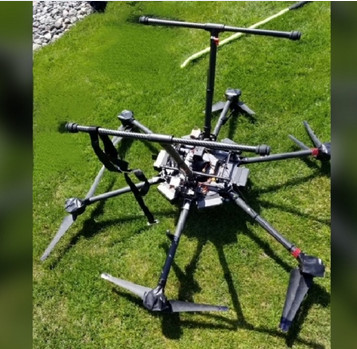
U.S.A. –-(AmmoLand.com)--On Friday, April 29, 2022, the Lambton branch of the Ontario Provincial Police seized a drone that had become stuck in the branches of a tree in the Canadian neighborhood. The payload of the drone was eleven handguns.
From torontoctvnews.com:
On Friday morning, Lambton OPP, with the help of the St. Clair Township Fire Department, used a bucket truck to retrieve a large drone from a tree located on the bank of the St. Clair River attached was a bag containing 11 handguns.
The tree was on a property belonging to Christine and Jeremy Ackwood.
“Our neighbour had spotted someone in our yard in the middle of the night and he had a remote control,” Christine explained. “He wasn’t sure what was going on.”That’s when things got very interesting. The stranger in the yard was spooked by Ackwood’s neighbour, and that’s when the stranger lost control of the drone and it crashed into the large trees in the Ackwood’s backyard.
Link to video from torontocvtvnews

The one handgun displayed by the police appears to be a sub-compact Glock with the serial numbers removed. It is one of tens (perhaps hundreds) of millions of guns in the United States which are unregistered and untraceable.
Millions of guns are not registered by design, to prevent the establishment of a national gun registry in the United States.
Port Lambton is on the St. Clair river, which is the boundary between Canada and the United States, 20 miles northeast of Detroit. The river, at this point, is less than half a mile wide.

The Saint Claire River is about 2000 feet wide at Port Lambdon. Image from Google maps.
Similar drones are available for under a thousand dollars. Prices range up to $20,000 for high-end drones which can carry the same 10 kilograms (22 lbs).
A drone flight could deliver 11 pistols in less than half an hour. There is a significant potential for black market profit.
“You will see a gun, a firearm purchased in the States for potentially $200 to $300, and they’ll go on the streets [in Canada] for $3,000.”
As with drug numbers, these are undoubtedly inflated based on what the retail buyer pays. They do not take into account the considerable risk and overhead in smuggling. Canada has a long tradition of being law-abiding. The market for black market handguns is not large.
However, Canada has a growing crime, gang, and immigrant problem. Most of the black market guns go to criminal gangs. At even $1,000 a gun profit, eleven guns are plenty to pay for the drone or a few drones. Most of the risk is on the retail end of the distribution. With digital trackers and GPS, retrieval of smuggled items has little risk. This operation appears to be by low-level novices.
Drones are the latest way of evading the border. Anyone with a kayak and some moxie could do the same thing, for much less money. A close friend with decades of experience policing the southern border listed several low-tech methods which work well. The most ingenious and cheapest, involves a water balloon launching slingshot. One of those can throw a handgun a hundred yards or more.
Opinion:
Handguns are a minuscule problem in Canada. Crime with guns has never been a big problem there. Crime with guns is increasing in Canada. The major reason is not smuggled guns from America.
The major reason for increasing crime in Canada is the law-abiding culture in Canada is being degraded by trust destroying government policies and the importation of non-Canadian cultural values.
About Dean Weingarten:
Dean Weingarten has been a peace officer, a military officer, was on the University of Wisconsin Pistol Team for four years, and was first certified to teach firearms safety in 1973. He taught the Arizona concealed carry course for fifteen years until the goal of Constitutional Carry was attained. He has degrees in meteorology and mining engineering and retired from the Department of Defense after a 30-year career in Army Research, Development, Testing, and Evaluation.

from https://ift.tt/xu9qZCE
via IFTTT

No comments:
Post a Comment